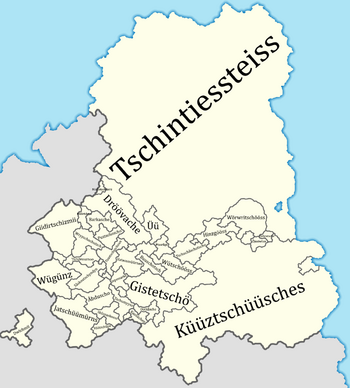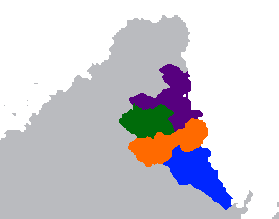Gintem Confederation
Gintem Confederation gen-she-den-rós-cin-de-den Genschedenrööss Hindeden | |
|---|---|
Motto: 'We rise' | |
 | |
| Capital | X |
| Official languages | Tschintierst Classical Doccábh (3399 CY – 3521 CY) |
| Demonym(s) | Gintem |
| Government | Mixed confederal intergovernmental elective constitutional monarchy |
| Ytytschooryn Wechtachz | |
| Legislature | United Council of the Various Lands of the Gintem Confederation |
| Noble Council | |
| Common Council | |
List of countries within the Gintem
| |
| Area | |
• | 699,902 km2 (270,234 sq mi) |
| This article is part of a series on |
| Gintem culture |
|---|
 |
| Countries |
| Languages |
| Religion |
| History |
| Culture |
| Related topics |
|
|
The Gintem Confederation is an association of 33 Tschintierst-speaking countries located in Northeast Yazland. The confederation covers and area of 699,902 km2 (270,234 sq mi) and has a combined population of X million people, not including overseas colonies of member states. The confederation has existed in some form since the fall of the Doccábhan Empire and Sendeasta Missísin’s division of its lands to the various Gintem tribal rulers. Since its formation the Gintem has been a powerful thorn in the side of various North Yazland nations, banding together to prevent any large scale outside attack, but constantly squabbling from within. The confederation is unique among organizations, being not a state, but also not a mere alliance; existing to mediate the various disputes between the rulers of the states that reside within it. In its modern form it has also served as a way to interact economically and politically with the various small states of the confederation without doing so individually, though states such as TSC and KSC still operate functionally independently of the confederation.
History
Doccábh-Gintem Wars
Collapse of the Doccábhan Empire and founding

Following the fall of the Doccábhan Empire, the Gintem Confederation would conquer much of the land on the Eastern Side of the Grese Mountains. The official founding of the Confederation would be in 3356 CY, though it had existed in a loose form for decades prior. Sendeasta Missisin would be elected as the first Archqueen Paramount of the Gintem Confederation, she would go on to add more land into the Gintem through the conquest of various Doccábhan remnant states, redistributing land to Gintem peoples following conquest. Missisin would die in 3397 CY with no biological heirs, and her lands in the Gintem Confederation would be split amongst various nobles. This would establish the tradition of Missisinic succession within the Gintem Confederation, whereupon the death of a monarch, a vote could be called by the Noble Council to split their land among various landowning successors. Maircességte the Great would succeed Missisin as Archking Paramount, and would institute numerous reforms to the confederation, establishing the Noble Council and the Common Council, as well as rolling back some of the anti-Doccábh edicts of Missisin's reign. Maircességte would also make Classical Doccábh the official literary language of the Confederation in 3399 CY, and records would be recorded primarily through Classical Doccábh for a century. Conquest of land from more Doccábhan remnant states would see the outbreak of disputes between the various member states of the confederation, and an eventual conflict in the Three Kings' War of 3411 CY. The war would see the Kingdom of Üü and the Duchy of Jatschüümürns come into conflict with the Kingdom of Gistetschö and the Kingdom of Tschurskyyjo. Maircességte would bring the war to an end in 3415 CY after the devastation proved too great. The war would see the Kingdom of Üü propelled into being the largest power of the confederation, and their King X would make an attempt for the position Archking Paramount after Maircességte's death in 3420. This would be thwarted by a bloc of anti-Üü voters in Gistetschö, Vrishia, Kriibüsche, Mödwritschööss, and Tschurskyyjo, and X of Kriibüsche would be elected instead. Following the death of X in 3432, Üü it would be subject to a Missisinic succession called by the Archking Paramount and his supporters, drastically reducing its size and influence.

Early Medieval history
Despite being within the winning side of the coalition against Üü, the King of Vrishia would grow concerned with the use of Missisinic succession within the confederation, and urged the Archking Paramount to use it as a last resort when no valid heirs are available. Archking Paramount X brushed off these concerns, and when the King of Vrishia became convinced his concerns would not be heard, he decided Vrishia would leave the Gintem Confederation. The legality of leaving the confederation had never been settled, so the result was Archking Paramount X arguing that the King of Vrishia had committed an act of treachery, while the King of Vrishia argued there was no law preventing him from leaving. The result was the Vrishtic War of 3438, where Vrishia would fight against Archking Paramount X and is allies for its independence. The war ended in 3443 as a Vrishtic victory, and the Gintem Confederation would permanently lose Vrishia as a member. After this war, Archking Paramount X would make it officially illegal to leave the confederation without a majority vote. Archking Paramount X would become unpopular throughout the confederation, and following his death in 3451, X of Üü would be elected as Archking Paramount. X would enact Missisinic succession on the states of Gistetschö, Tschurskyyjo, and Kriibüsche during his reign as Archking Paramount, cementing a decades-long feud between the states of Gistetschö and Üü. Following the death of Archking Paramount X in 3463, Missisinic succession would fall out of fashion, being perceived as a tyrannical power. Following the election of Archking Paramount X, Missisinic succession would be outlawed except in cases of open rebellion against the Archking Paramount or when a king died without a viable heir. The Gintem Confederation would remain mostly static for several years until tensions between the Duchy of Tschåchrumnooss and the Kingdom of Marküüche over a border fortress exploded into Tschüpeesta's War in 3474. Calls for peace and intervention by other members of the confederation would be met with indifference by Archking Paramount X, who allowed the war to go on until its conclusion in 3479. In 3481, the Gintem would be invaded by the Empire of Vahtyas. The leader(s?) of Vahtyas, having descended from Doccábhan imperial remnants, sought to reclaim what they viewed as their homeland. This mark the beginning of the Wars of the Birthright, a 20 year long military conflict between the various states of the Gintem Confederation and the Empire of Vahtyas. Most fighting would take place in Jatschüümürns, Tschurskyyjo, and Mödwritschööss, seeing the southern half of the confederation devastated by frequent raids and warfare. X. The conflict would end inconclusively in 3501 CY, seeing lands in Jatschüümürns and Mödwritschööss ceded to the Empire of Vahtyas, but with the leader(s?) of Vahtyas ultimately failing in their goal to reclaim the lands of the Gintem.

